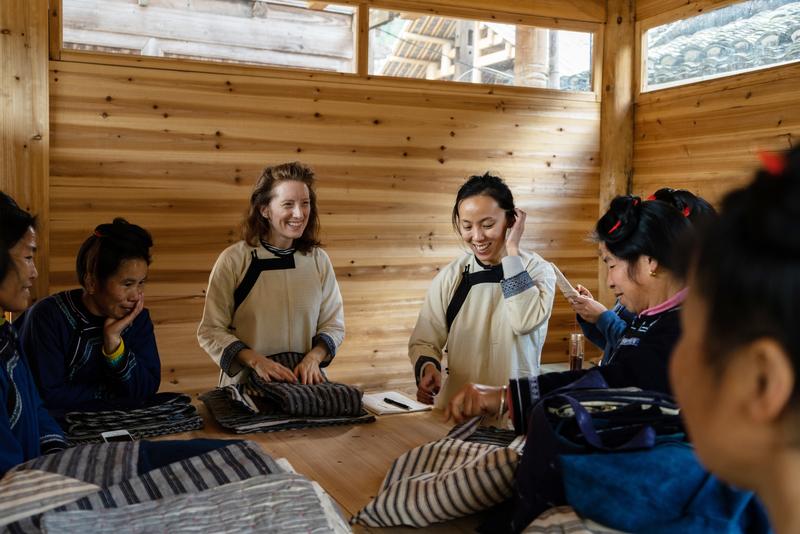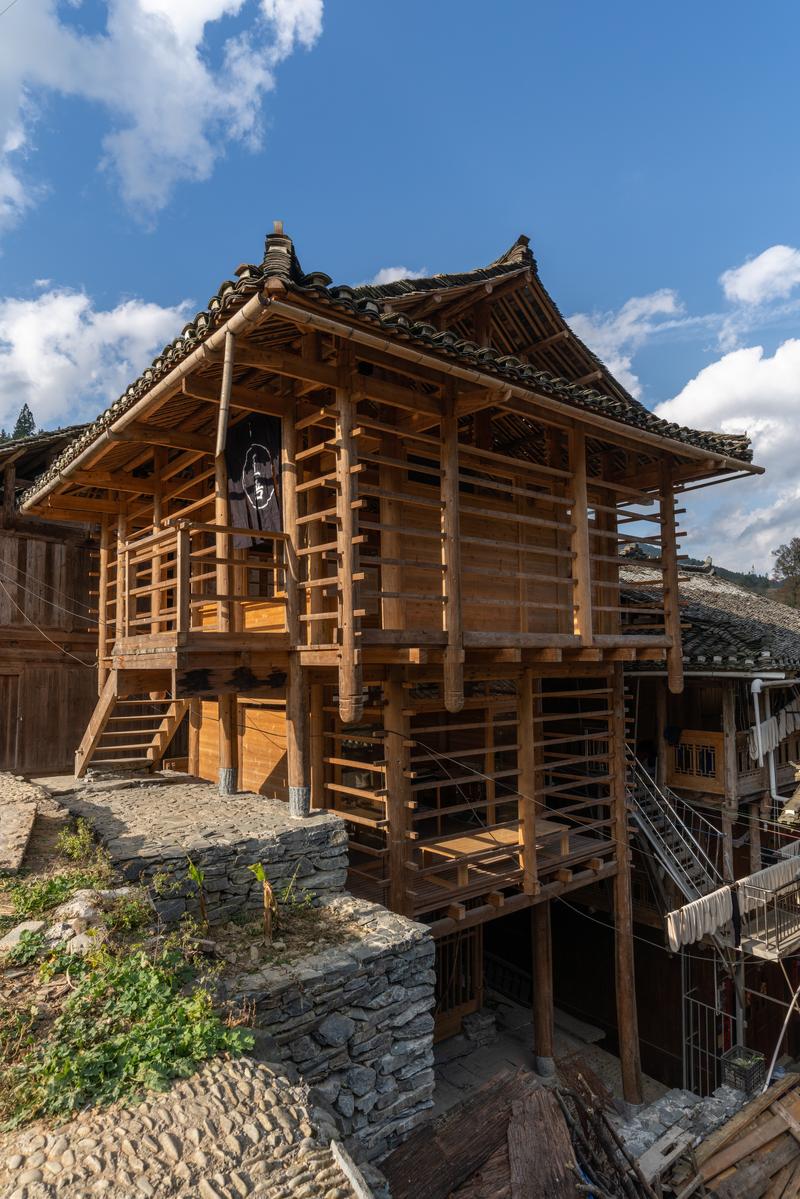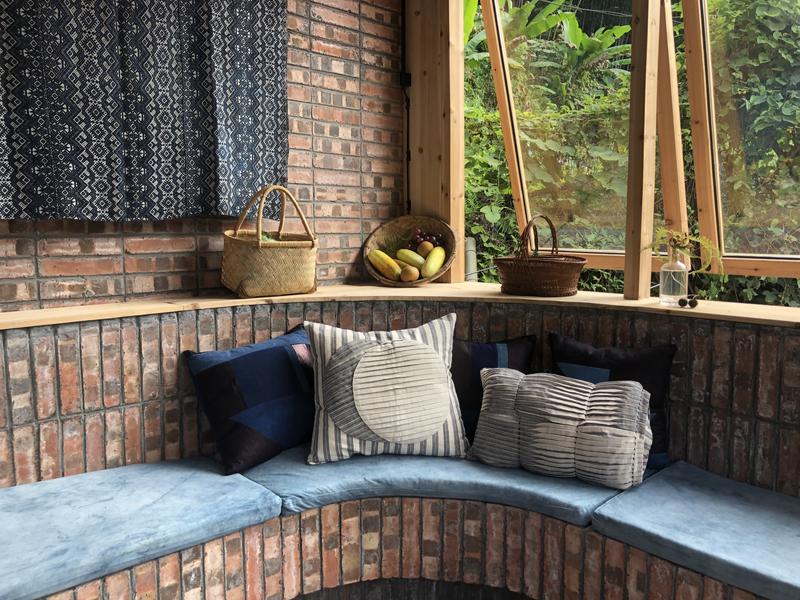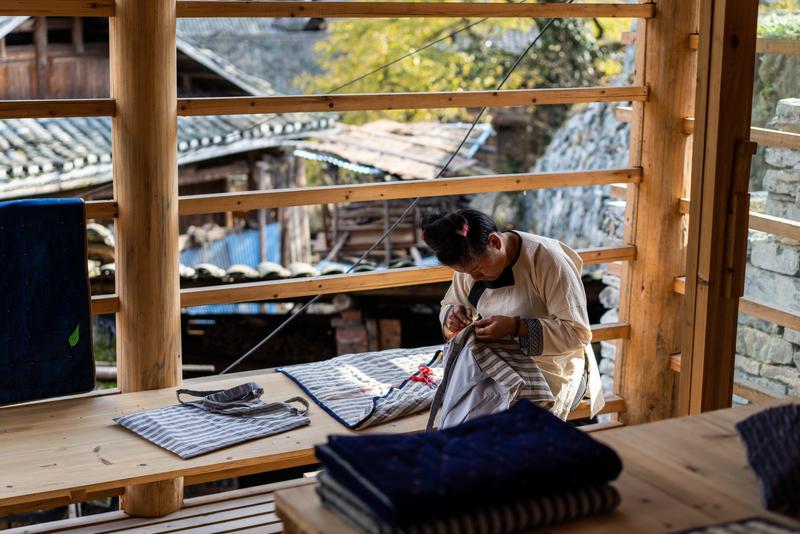Architect's vision helps establish a cultural project that empowers women of the Dong ethnic group, report Wang Qian in Beijing and Yang Jun in Guiyang.
 Jenny Chou (right in white) and her colleague work with local women of the Dong ethnic group at the community center in Dali village, Guizhou province. (PHOTO PROVIDED TO CHINA DAILY)
Jenny Chou (right in white) and her colleague work with local women of the Dong ethnic group at the community center in Dali village, Guizhou province. (PHOTO PROVIDED TO CHINA DAILY)
The book was there, on a shelf at her home. And when curiosity got the better of her and she opened it, her life changed. More than 10 years ago, Imprints on Cloth, by two Japanese anthropologists on textile traditions in Southwest China's Guizhou province, amazed and astounded Jenny Chou. As the title suggests, this was not a detective story, but then maybe it was, but the main players were fabric and technique.
She didn't expect that one day she would help introduce douran-a botanic dyeing method-to people across the world. It uses a dye-resistant agent mixing soybean powder, pulverized lime, egg white and local vinegar and indigowoad root as a dye to make the blue or dark, glossy cloth.
Despite being handed down over the course of centuries by generations of women from the Dong ethnic group in a remote village in Guizhou, the craft, once a normal part of their daily life, is seldom practiced by local young people. To find new outlets and provide a contemporary context for the traditional craft, a project was launched in Guizhou's Dali village in 2015 by the Global Heritage Fund, a nongovernmental preservation organization in the United States, and Beijing-based Atlas Studio with Chou as co-founder.
 The community center in Guizhou's Dali village is built in the local, traditional style. (PHOTO PROVIDED TO CHINA DAILY)
The community center in Guizhou's Dali village is built in the local, traditional style. (PHOTO PROVIDED TO CHINA DAILY)
In 2017, Chou and her team brought Dali artisans and their craft to Beijing Design Week. In October of that year, the textile project won second place in a contest held during the China Intangible Cultural Heritage Week in Danzhai, Guizhou.
Their textile homewares, such as pillows, bags and cushions, have been sold in specialized shops in Beijing and Shanghai, with a price tag ranging from hundreds to thousands of yuan. This year, an online store for the items is expected to launch, according to Chou.
"Through the project, I hope that a sustainable business model can be created to empower the local women," she says.
Nestled among karst mountains, rice terraces, and wooded hillsides, Dali village has a Dong population of more than 1,000, with a history that can be traced back to the Ming Dynasty (1368-1644). Although many young people have left the village to work or study in big cities due to the country's fast urbanization, the villagers who remain still live by the same traditions as their forebears did for hundreds of years, planting rice and vegetables, building wooden houses and making cloth by hand.
Influences from the outside world have made their presence felt, but generally villagers have retained their self-sufficient lifestyle.
"It seems that we are trying to empower the women here, but their sustainable way of living is a lesson that we can learn from them," Chou says.
 Homewares made by the Dong women add local comfort to the Well House, a boutique hotel in the village designed by Chou's team. (PHOTO PROVIDED TO CHINA DAILY)
Homewares made by the Dong women add local comfort to the Well House, a boutique hotel in the village designed by Chou's team. (PHOTO PROVIDED TO CHINA DAILY)
Community center
Born in Taiwan and immigrating with her family to the United States in the 1990s, Chou earned her architecture degree at the Rhode Island School of Design in 2004, and her master's degree at Columbia University in 2008.
With her grandfather being born in Hubei province, and grandmother hailing from Sichuan province, Chou had been curious about the Chinese mainland. After graduation, she set up the design studio in Beijing with two friends who she studied architecture with at the Rhode Island School of Design.
Although it was not the first village that she visited in China, the pristine environment in Dali still impressed Chou when she first arrived in 2015 during a trip with the Global Heritage Fund.
"The village has preserved the local architectural heritage and cultural history well, and it can be a model for the country's rural revitalization plan," Chou says.
With no written language, the Dong ethnic group passes on its culture and knowledge by song and folklore. The village was built along a stream with five ancient stone bridges. Wooden stilt houses cluster around a drum tower and an altar to Sasui, a highly regarded female deity among the Dong people. It was included in the country's traditional village protection project in 2012.
Two years later, as the project grew in scope, Chou started designing and building a community center to support the textile work.
"The design of the center has provided an opportunity for my team to explore the traditional carpentry and masonry practiced by the local craftsmen and to re-imagine a contemporary use and articulation for traditional buildings and public spaces," she says.
The three-story center is built in the public square in front of the drum tower, with its first floor being used for storage, its second employed as a textile workshop and its third providing a space for exhibitions.
"It means that a new type of public space necessitates the adaptation of Dong typology and traditional building practice to accommodate contemporary programmatic needs," Chou says, adding that the key for the workshop was to make it as bright and airy inside as possible, as many Dong homes are dark.
For the 16th edition of the Venice Biennale of Architecture in 2018, the Dali project was shown as part of the Across Chinese Cities exhibition, thanks to its efforts in exploring a planning approach linked to the development of "communities" as mechanisms which create new systems of social, economic and spatial belonging.
 A Dong woman weaves a blanket at the community center. (PHOTO PROVIDED TO CHINA DAILY)
A Dong woman weaves a blanket at the community center. (PHOTO PROVIDED TO CHINA DAILY)
Hotel building
After building the community center, Chou, in one of those moments that seemed ordained by destiny, got invited to design and build a hotel in Dali village.
In 2015, Zhang Shiba, who is from Guiyang, Guizhou province, decided he wanted to live a different life and closed his advertisement company in Guangzhou, Guangdong province. When he entered Dali village, he thought that it was like "a place in a fairy tale". After traveling to Dali three times to make sure, he decided to move there and open a hotel.
Living in Dali for about two years, he witnessed the completion of the community center and decided to invite Chou to design his second hotel, known as the Well House, which is located above an old well.
Perched on the mountainside high up in the village and using local cedarwood and bricks, the hotel attempts to maintain the local aesthetic so as not to disturb the skyline."Through the use of energy-efficient heating and weatherproofing materials, the building is built without air conditioners," Chou says.
The boutique hotel was a nominee for Building of the Year 2021 in the Hospitality Architecture section of US-based industry news portal ArchDaily.
According to ArchDaily, it is a new boutique hotel that aims to situate itself contextually in the simple and austere lifestyle of the village. It adds that the designers have found ways to update the traditional methods of building with contemporary amenities and evolved design without losing the integrity that makes Dali what it is.
"As the village finds a bridge to the future and looks to tourism and exchange to do so, the hope is that the Well House presents thoughtful solutions for merging the old with the new," the Atlas Studio says.
For Chou, the hotel can bring more tourists to the village and in turn, they can come to the community center to learn about the textile craft, which will set up a sustainable business chain for Dali.
Li Kuanghan, director of the China Heritage Program at Global Heritage Fund, says that the method of preserving Dali village is a good example for rural heritage protection.
Contact the writers at wangqian@chinadaily.com.cn



